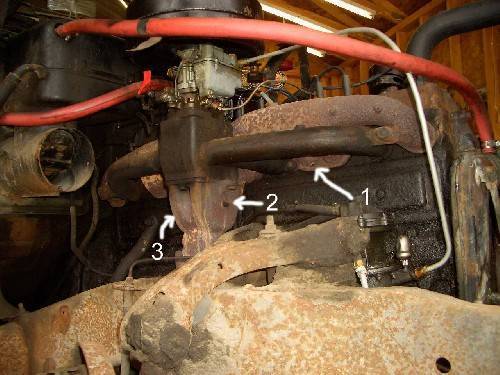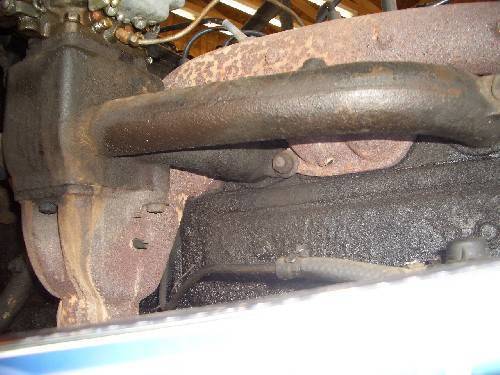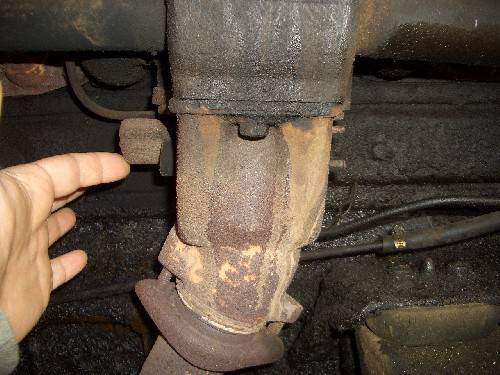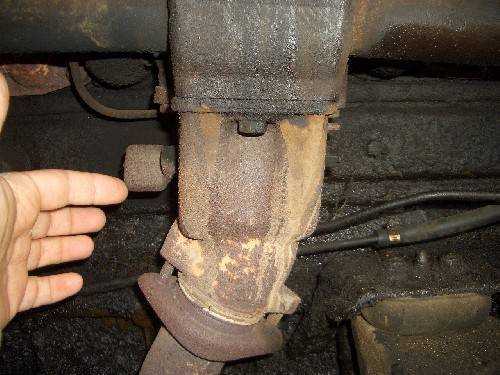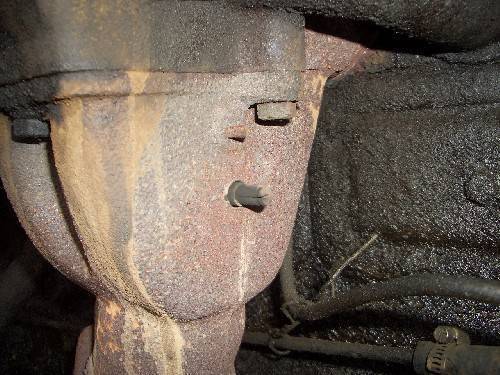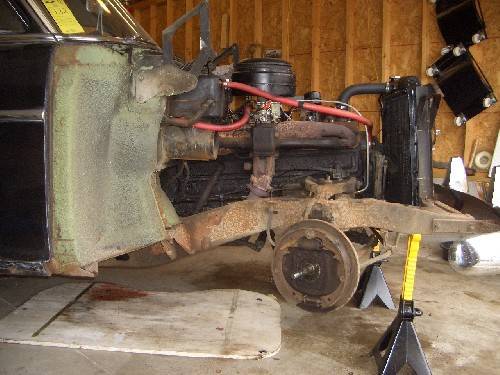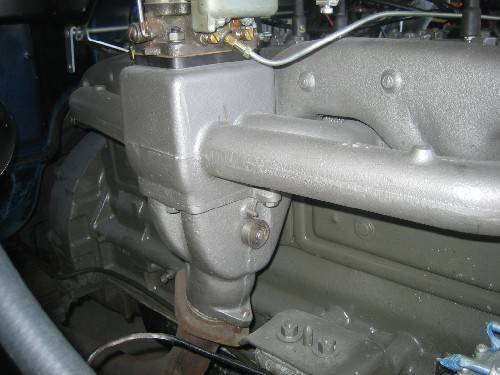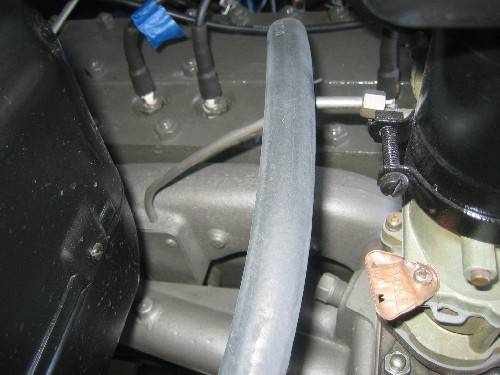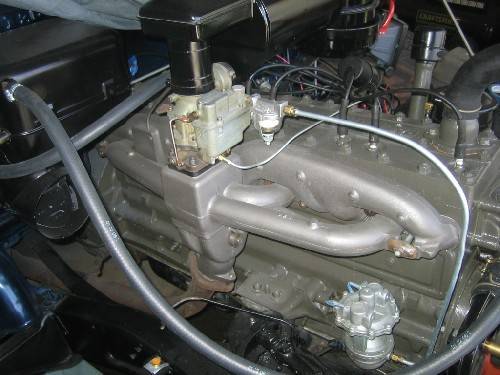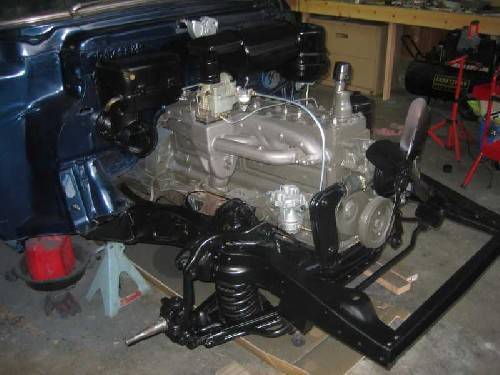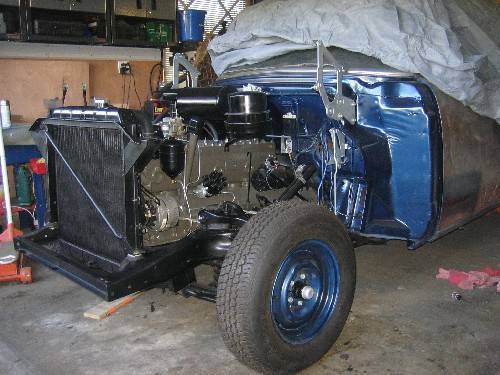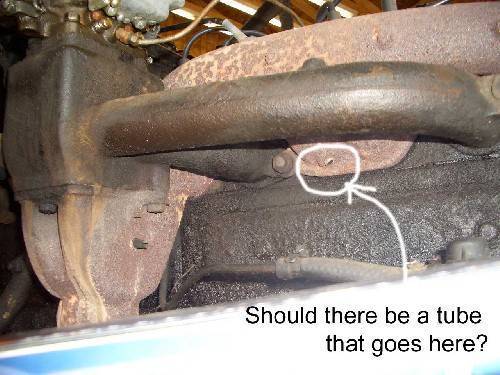|
Re: Carl's 1952 Packard 300
|
||||
|---|---|---|---|---|
|
Forum Ambassador
|
The antenna body or if present a small wire out of the motor lead is ground. The motor has two separate oppositely wound field coils tied together at one side of armature, other side of armature to case ground. Only one of the lead wires used at a time--one is up, the other down. The center of up/down switch connects to the circuit breaker.
From what I can see, maybe 2' of the nylon has broken off. The usual failure, aside from broken mast is for various reasons the mast sticks but motor keeps turning and either breaks or wears a spot in the nylon. Once the worn spot hits the drive rollers, it rarely goes any further & just gets worse. New repro mast assys were or are available for a price from some of the vendors, but have not been able to find just the nylon for either style antenna
Posted on: 2009/4/28 22:26
|
|||
|
||||
|
Re: Carl's 1952 Packard 300
|
||||
|---|---|---|---|---|
|
Home away from home
|
I got the right fender off as well! I'm really cooking now. Only a couple snapped bolts, but the two holding the fan to the fender were two of them; they are held in place with a small ring around the bolt, so I'll have to reproduce them.
I'm now trying to track down the exhaust leak in the exhaust manifold. Three obvious spots stand out: both sides of the pre-heat baffle where the shaft extrudes (#2 and #3), and then a small vacuum type tube under the exhaust manifold between the second and third cylinder (#1). See the pictures below. I ran the motor for 20 minutes, and the temperature of the head was evenly distributed from the front to rear. I checked the coolant and it was getting warm also; I wouldn't call it 'hot'. I need to find my digital thermometer for a less subjective inspection. I sprayed starting fluid in many different locations trying to find an intake leak, but none where found. Moving the exhaust manifold baffle counterbalance did not change how the motor ran; does this mean the baffle is gone? Also note on the last picture the excess tranny fluid on the white plywood...another problem...
Posted on: 2009/4/29 14:10
|
|||
|
-Carl | [url=https://packardinfo.
|
||||
|
||||
|
Re: Carl's 1952 Packard 300
|
||||
|---|---|---|---|---|
|
Forum Ambassador

|
The hole you see underneath, your #1, is just the far end of the stove for the automatic choke. It's just a piece of steel tube swedged into the manifold so the automatic choke unit can draw heated air as the engine warms up. If in fact you feel exhaust coming out of it, then the tube has corroded away inside. Relatively easy fix, but when you swedge the ends of the new piece of steel tube, remember how brittle the cast iron is!!
I don't think with just running the engine as you did you'd notice any difference with the exhaust manifold heat riser valve in one position or the other. Remember, it's just deflecting hot gases towards the base of the carburetor to aid in the vaporization of fuel during warm up. You can get a new thermostatic bimetallic spring for it; the spring will hold it closed (counterweight up) when cold and as the spring heats, it unwinds and allows the counterweight to drop, thus opening the baffle. Regarding your exhaust leak, check the joint where the exhaust pipe meets the manifold first, that's often where the leak is. If not there, you might want to carefully tighten the manifold bolts but BEWARE - if the gasket is blown out behind one of the ears, you risk breaking the manifold. Best bet, and it's easy with the fender removed, take off the manifolds but keep them bolted together for the moment, and have your machine shop check them for flatness. If OK, reinstall with new gaskets, including the one in the heatbox.
Posted on: 2009/4/29 14:30
|
|||
|
||||
|
Re: Carl's 1952 Packard 300
|
||||
|---|---|---|---|---|
|
Home away from home
|
Thanks Dave; I think I will remove the manifolds. So, the automatic choke tube; where does it go, where should it go?
Also, the leaks around the shaft of the exhaust manifold heat riser; how do I plug those leaks AND allow the heat riser to operate?
Posted on: 2009/4/29 15:03
|
|||
|
-Carl | [url=https://packardinfo.
|
||||
|
||||
|
Re: Carl's 1952 Packard 300
|
||||
|---|---|---|---|---|
|
Forum Ambassador

|
Re the choke, remember that the tube in the manifold is sealed at both ends at its outside diameter to keep the exhaust gases within the manifold, yet is open at both ends at the inside diameter. The choke line from your Carter automatic choke should enter that tube at the top. The choke uses a small amount of vacuum to draw the air from inside the tube, when the air is sufficiently warm it indicates to the choke that the engine is warming, and the heat from it begins to unwind a bimetallic spring in the choke, allowing the choke butterfly valve to progesssively open.
Regarding the heat riser, you'll have to look more closely, usually the shaft rides in sleeves. A minute amount of leakage is inevitable but normally can't be heard. If yours leaks profusely, perhaps the shaft is severely worn (not too likely), or the sleeves if it has them are worn. Maybe it isn't sleeved and you could bore and sleeve. Others who are particularly familiar with your model will comment in detail.
Posted on: 2009/4/29 15:15
|
|||
|
||||
|
Re: Carl's 1952 Packard 300
|
||||
|---|---|---|---|---|
|
Webmaster
|
Carl, here are some pics that may help.
First one is the spring for the heat riser, got mine from Kanters. The second one shows the exhaust heat tube from the rear of the manifold to the carb on my '54. Not sure if your manifold may be different. The third is just a side view of the manifold/motor. Also you may want to move your jack stand back further, as you are supporting the greatest amount of weight with the narrowest part of the frame. I actually support mine where the frame rail and x-frame meet. Just in front of the firewall as the frame is still straight (flat) here so it sits nice and level on the jackstands. Some of the other folks also like to use the engine cross member.
Posted on: 2009/4/29 16:15
|
|||
|
-BigKev
1954 Packard Clipper Deluxe Touring Sedan -> Registry | Project Blog 1937 Packard 115-C Convertible Coupe -> Registry | Project Blog |
||||
|
||||
|
Re: Carl's 1952 Packard 300
|
||||
|---|---|---|---|---|
|
Forum Ambassador

|
Kev, that motor's almost too pretty for a car, should be perhaps in a showroom or on a mantle (a large one).
Posted on: 2009/4/29 16:45
|
|||
|
||||
|
Re: Carl's 1952 Packard 300
|
||||
|---|---|---|---|---|
|
Webmaster
|
Thanks Dave, It's amazing how good they stay looking when they are not running! Here is one of my favorite shots.
Posted on: 2009/4/29 16:57
|
|||
|
-BigKev
1954 Packard Clipper Deluxe Touring Sedan -> Registry | Project Blog 1937 Packard 115-C Convertible Coupe -> Registry | Project Blog |
||||
|
||||
|
Re: Carl's 1952 Packard 300
|
||||
|---|---|---|---|---|
|
Home away from home
|
BigKev, Dave-
So, please clarify; is there a tube that comes out of this hole? I have a lot of exhaust coming out of it now. The tube must have corroded away inside... Quote: The hole you see underneath, your #1, is just the far end of the stove for the automatic choke. It's just a piece of steel tube swedged into the manifold so the automatic choke unit can draw heated air as the engine warms up. If in fact you feel exhaust coming out of it, then the tube has corroded away inside. Relatively easy fix, but when you swedge the ends of the new piece of steel tube, remember how brittle the cast iron is!! Okay, but I don't understand this: Quote: Re the choke, remember that the tube in the manifold is sealed at both ends at its outside diameter to keep the exhaust gases within the manifold, yet is open at both ends at the inside diameter.
Posted on: 2009/4/29 18:06
|
|||
|
-Carl | [url=https://packardinfo.
|
||||
|
||||

 (140.47 KB)
(140.47 KB)